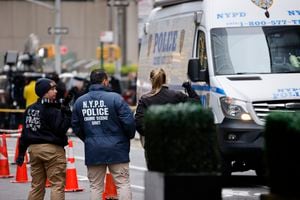The intense manhunt for the suspected gunman responsible for the death of UnitedHealthcare CEO Brian Thompson has prompted a significant collaboration between the Atlanta and New York police departments. Investigators have traced the shooter’s movements to a Greyhound bus arrival in New York City on November 24, just ten days prior to the incident. Recent developments indicate that the NYPD has located what they believe is the suspect’s backpack, which was discovered in Central Park during an extensive search involving numerous officers and drones. Preliminary evidence suggests the suspect was seen with the bag before the shooting, but surprisingly, video footage captured shortly after the incident shows him riding a bicycle without the backpack.
As the investigation unfolds, the details surrounding the suspect’s identity have come to light. The New York Police Department has released images of the gunman, who had checked into a hostel on Manhattan’s Upper West Side using a fictitious name and a New Jersey identification. There are hints of a peculiar interaction at the hostel reception, where the clerk was required to take a photo of the guest for security purposes, potentially providing further identification clues. Authorities are now scrutinizing whether the suspect managed to flee the city via bus post-shooting, while the Greyhound company has confirmed their full cooperation with the ongoing investigation.
To aid in their search for the shooter, investigators are meticulously analyzing pieces of evidence, including a discarded water bottle and a protein bar wrapper, in hopes of obtaining DNA. They are also trying to extract data from a cellphone found along the suspect’s escape route. Reports indicate that the shooter likely possessed prior firearms training, as indicated by the methodical execution of the crime caught on surveillance. Security footage reveals the assailant approaching Thompson from behind and firing multiple shots using a silenced firearm, exhibiting remarkable composure, even pausing only briefly to clear a jammed weapon.
The chilling details surrounding Thompson’s murder have raised eyebrows, especially concerning inscriptions found on the ammunition used in the shooting. Phrases such as “deny,” “defend,” and “depose” were reportedly scribbled on the rounds, echoing the criticism often levied against insurers for delaying claim payments and denying coverage. This connection suggests that the perpetrator may have had personal or professional grievances against Thompson or the larger insurance landscape. The implications of the shooting extend beyond the immediate tragedy, signaling potential unrest within the corporate arena.
Thompson, a father of two sons, had been a critical figure within UnitedHealthcare since 2004, serving as CEO for more than three years. His untimely death occurred during a high-profile annual investor meeting for UnitedHealth Group Inc. in New York, forcing the company to abruptly conclude the event. The corporate giant expressed its deep grief over Thompson’s loss and prioritized supporting his family and the well-being of its employees throughout this catastrophic event. UnitedHealthcare’s significant role in providing health insurance for over 49 million Americans underlines the impact of this tragedy on a wider scale.
The repercussions of the shooting reverberate throughout corporate America and particularly the health insurance sector, leading firms to reassess their security protocols. Various companies are taking precautions such as removing executive photographs from their websites and advising employees to work from home out of an abundance of caution. It marks a profound moment of reflection within the industry, highlighting a need for enhanced protection for executives and an awareness of the increased risks that the changing societal landscape may pose. The entire situation represents a significant pivot point in the ongoing discourse surrounding corporate security and personal safety in the modern workforce.

